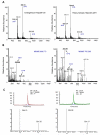Effects of a single dose of oral iron on hepcidin concentrations in human urine and serum analyzed by a robust LC-MS/MS method
- PMID: 21867695
- PMCID: PMC3207492
- DOI: 10.1016/j.cca.2011.08.014
Effects of a single dose of oral iron on hepcidin concentrations in human urine and serum analyzed by a robust LC-MS/MS method
Abstract
Background: The measurement of serum hepcidin, a peptide hormone that regulates iron metabolism, is clinically important to the understanding of iron homeostasis in health and disease. To date, the quantification of serum hepcidin levels by conventional immunological detection methods has proven problematic due to challenges in obtaining high quality antibodies which demonstrate good reproducibility. Matrix-assisted laser desorption/ionization time-of-flight mass spectrometry (MALDI-TOF) has been employed recently for more sensitive quantification of hepcidin; however, this method has high background levels and therefore less than optimal specificity.
Methods: In order to increase the specificity of the mass spectrometry based assay, we developed a robust, ultra-performance liquid-chromatography-tandem mass spectrometry (UPLC-MS/MS) protocol using multiple selected reaction monitoring (mSRM) for quantification of hepcidin levels in urine and serum of human subjects. With this assay, we assessed levels of hepcidin before and for up to 8 h after oral ingestion of ferrous sulfate in ten adult human subjects without known disease.
Results: The linear response of hepcidin quantitation on each instrument was measured, and the correlation coefficients of these calibrations were r(2)=0.9512±0.0202 (n=5) for urine and r(2)=0.9709±0.0291 (n=5) for serum [r(2)=mean±SD]. Compared to baseline, the levels of urinary hepcidin between 2-4 h and 4-8 h of both women and men showed significant increases with p<0.05 and p<0.001, respectively. The levels of serum hepcidin between 4 h and 8 h in both women and men showed significant increases, compared with baseline values, with both p<0.01. Interestingly, we also observed some degree of oscillation of levels, occurring at later time points.
Conclusions: We have developed and validated a new method for measuring hepcidin concentrations in human serum and urine and used it to demonstrate early increases with iron supplement in both urinary and serum levels of hepcidin, which return to baseline levels, except in urine samples from men.
Copyright © 2011 Elsevier B.V. All rights reserved.
Figures





Similar articles
-
Mass spectrometry-based hepcidin measurements in serum and urine: analytical aspects and clinical implications.Clin Chem. 2007 Apr;53(4):620-8. doi: 10.1373/clinchem.2006.079186. Epub 2007 Feb 1. Clin Chem. 2007. PMID: 17272487
-
A sensitive and cost-effective high-performance liquid chromatography/tandem mass spectrometry (multiple reaction monitoring) method for the clinical measurement of serum hepcidin.Rapid Commun Mass Spectrom. 2020 Apr;34 Suppl 1:e8644. doi: 10.1002/rcm.8644. Epub 2020 Feb 20. Rapid Commun Mass Spectrom. 2020. PMID: 31671212
-
Advances in quantitative hepcidin measurements by time-of-flight mass spectrometry.PLoS One. 2008 Jul 16;3(7):e2706. doi: 10.1371/journal.pone.0002706. PLoS One. 2008. PMID: 18628991 Free PMC article.
-
[Role of iron metabolism-regulator hepcidin in perinatal iron homeostasis].Orv Hetil. 2010 Jan 17;151(3):83-91. doi: 10.1556/OH.2010.28773. Orv Hetil. 2010. PMID: 20061265 Hungarian.
-
Hepcidin assay in serum by SELDI-TOF-MS and other approaches.J Proteomics. 2010 Jan 3;73(3):527-36. doi: 10.1016/j.jprot.2009.08.003. Epub 2009 Aug 13. J Proteomics. 2010. PMID: 19683083 Review.
Cited by
-
Effect of Intravenous Iron Supplementation on Hepcidin Levels in Iron Deficient Pregnant Females in Second and Third Trimester.Indian J Hematol Blood Transfus. 2017 Sep;33(3):396-401. doi: 10.1007/s12288-016-0736-1. Epub 2016 Oct 31. Indian J Hematol Blood Transfus. 2017. PMID: 28824243 Free PMC article.
-
Catechins in dietary supplements and hepatotoxicity.Dig Dis Sci. 2013 Sep;58(9):2682-90. doi: 10.1007/s10620-013-2687-9. Epub 2013 Apr 27. Dig Dis Sci. 2013. PMID: 23625293 Free PMC article.
-
A Targeted Mass Spectrometric Assay for Reliable Sensitive Hepcidin Quantification.Sci Rep. 2019 May 13;9(1):7264. doi: 10.1038/s41598-019-43756-9. Sci Rep. 2019. PMID: 31086210 Free PMC article.
References
-
- Ganz T. Hepcidin, a key regulator of iron metabolism and mediator of anemia of inflammation. Blood. 2003;102:783–788. - PubMed
-
- Nemeth E, Valore EV, Territo M, Schiller G, Lichtenstein A, Ganz T. Hepcidin, a putative mediator of anemia of inflammation, is a type II acute-phase protein. Blood. 2003;101:2461–2463. - PubMed
-
- Park CH, Valore EV, Waring AJ, Ganz T. Hepcidin, a urinary antimicrobial peptide synthesized in the liver. J Biol Chem. 2001;276:7806–7810. - PubMed
-
- Pietrangelo A. Hepcidin in human iron disorders: therapeutic implications. J Hepatol. 2011;54:173–181. - PubMed
Publication types
MeSH terms
Substances
Grants and funding
LinkOut - more resources
Full Text Sources
Medical

